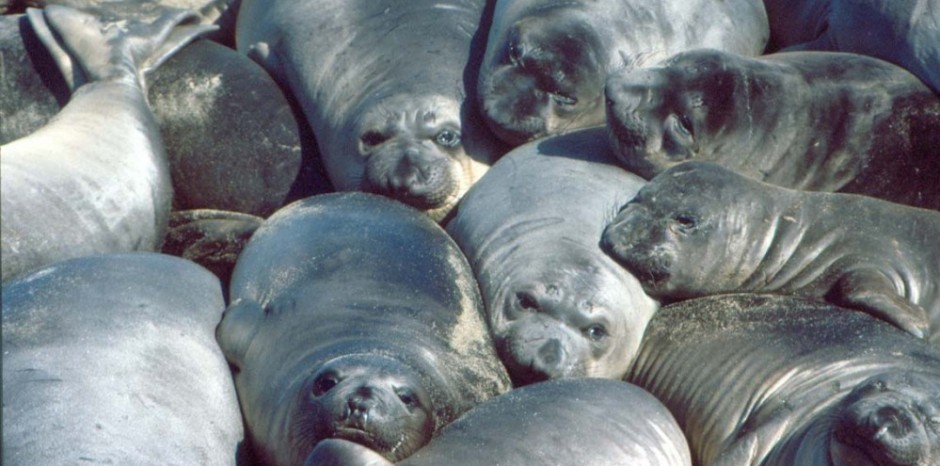HISTORY
The Physiological Ecology and Bioenergetics Lab (PEBL) relocated to UCF in 2001 after a 10 year relationship with Texas A&M University at Galveston. The endowed position of Hubbs-SeaWorld Professor of Marine Mammalogy was created in 2001 with a generous donation from Hubbs-SeaWorld Research Institute (HSWRI) and this resulted in the hiring of Dr. Graham A.J. Worthy as both the Hubbs-SeaWorld Professor of Marine Mammalogy and the Provost’s Distinguished Research Professor of Biology. Through UCF cooperative agreements, PEBL enjoys strong working relationships with Disney’s Animal Kingdom and Sea World of Florida.
MAJOR RESEARCH
The ultimate goal of the Physiological Ecology and Bioenergetics Lab (PEBL) is to better understand marine ecosystem function, and ultimately ocean health, by examining the interrelationships between different species and how those species respond to natural and anthropogenic perturbations. To accomplish this goal we need to examine biological systems at a variety of levels. First, we need to understand how individual animals derive their nutritional needs from their environment by studying their energetics, growth, and nutrition. To achieve this we integrate laboratory and field based investigations to elucidate the capabilities of different species to withstand normal seasonal variation in their environment as well as understanding how human induced change can impact them. Ultimately we need to integrate information on individual needs up to a population or species level so we can understand the relationships between different species. To accomplish this, we use a variety of tools to look at the feeding ecology and movement patterns of species which live and move across large spatial scales.
GOALS
The PEBL program includes ongoing investigations into the life history and physiological ecology of manatees, cetaceans, and pinnipeds at study sites around the world. Over the years we have undertaken research projects examining the metabolic needs and feeding ecology of a number of marine mammal species including killer whales, harbor porpoises, bottlenose dolphins, common dolphins, spotted and spinner dolphins, manatees, California sea lions, Steller sea lions, harp seals, grey seals, Hawaiian monk seals, and elephant seals. More recently we have initiated investigations into marine turtles and several species of megaherbivore, such as giraffes, rhinos, hippos and elephants. The lab is currently involved in studies using techniques such as indirect calorimetry, proximate composition analysis of prey, doubly-labeled water energetics, stable isotope analysis, and fatty acid signature analysis. Many of these studies are facilitated by recent and/or on-going partnerships with organizations such as Emerald Coast Wildlife Refuge, Sarasota Dolphin Research Project, Dauphin Island Sea Lab, Sea World, Disney’s Animal Kingdom, Vancouver Aquarium (Canada), Alaska Department of Fish and Game, National Marine Fisheries Service, Florida Fish and Wildlife Conservation Commission, Florida Marine Research Institute, National Zoological Park, U.S. Fish and Wildlife Service, and the Centre for Dolphin Studies (South Africa).
RESOURCES
PEBL personnel have considerable experience in the investigation of energy metabolism and feeding ecology of marine vertebrates. This team has broad experience in the assessment of energy requirements through the application of indirect calorimetry, doubly-labeled water methodologies, body condition estimation techniques, telemetry, and measures of insulative quality with pinnipeds, cetaceans, and sirenians. In recent years, the assessment of feeding ecology has been of prime interest and the lab has been actively investigating the calibration and application of stable isotope analysis and fatty acid signature analysis to various marine vertebrates, in addition to utilizing traditional methods of examining the proximate composition and energy content of predators and their prey. PEBL is housed in the Biological Sciences Building of the University of Central Florida. We have access to state-of-the-art research laboratories, as well as the boats and vehicles required to undertake field studies of free-ranging marine vertebrates.
The program is equipped with, or has access to, a full suite of analytical equipment including all of the required instrumentation for sample preparation and analysis of fatty acids, alkanes, and stable isotopes. Fatty acids and alkanes are analyzed on two Perkin Elmer Autosystem II FID autoanalyzer gas chromatographs connected to a computerized integration system using the software package Turbochrome 6. Stable isotopes are analyzed using our Delta Finnigan Mat isotope ratio mass spectrometer with an attached ConFlo III high temperature pyrolysis elemental analyzer that allows for high precision measurements of carbon, nitrogen, oxygen, sulfur, hydrogen and deuterium stable isotopes from organic and inorganic materials. We also have access to freeze driers, atomic absorption spectrophotometers, and a full suite of equipment for the proximate composition analysis of predator and prey (including ultracold freezers, Soxhlet systems, a Kjeldahl system, ashing ovens, etc). We have extensive experience in assessing body condition of live animals through the use of deuterated and tritiated water, leptin, Bioelectrical Impedance Analysis (BIA), and ultrasound methodologies.
The lab is fully equipped for undertaking indirect calorimetry measurements (oxygen consumption and carbon dioxide production) of marine vertebrates using a FC-1B oxide cell analyzer and a CA-1B infrared gas analyzer equipped with a TR-BL1 baselining unit and the PC-3 Peltier Effect Condensing Air Dryer (Sable Systems International, NV, USA). Airflow through the respirometer is maintained using a flow generator and controller (500H Flow Kit, Sable Systems). Our indirect calorimetry equipment can be used in conjunction with our Mobile Energetics Lab (MEL). This is a 12’ trailer that is outfitted with air-conditioned lab facilities and a separate area holding a heat exchanger system that can be used to control water temperatures (± 1°C) in holding tanks of up to 5000 gallons. Thermal images, to identify areas of heat loss, can be taken with a FLIR Systems ThermaCAM P20 (FLIR Systems, Boston, USA).
